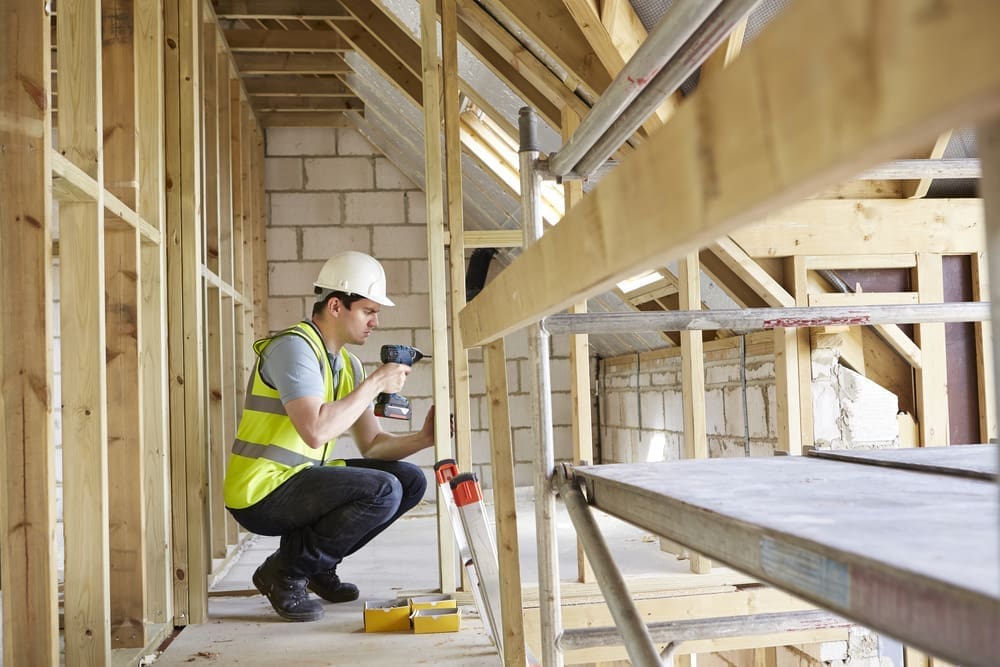Passive house construction depends a great deal on creating more opportunities for insulation. Thicker walls, achieved by building a double stud wall, create this opportunity, but with some complications. Too much insulation combined with tight sheathing can lead to moisture buildup over time, leading to condensation and other problems. When you’re building a home with extra thick walls and extra insulation, it’s important to do the work right to prevent that type of buildup. Here’s what to know about creating double studded walls for passive house construction.
What Are Double Studded Walls?
Double studded walls are used in homes and other structures to achieve greater thermal comfort through extra insulation. Double studded walls are highly efficient at stopping drafts, preventing air leaks, and preventing energy transfer from the structure’s interior to exterior. When built correctly, they can prevent thermal bridging as well.
Moisture control and drying potential are top considerations when building a double studded wall. It’s important to use the right materials, like the right rain screen, to ensure the wall is protected from elements and yet able to breathe appropriately. In the hands of an experienced builder and designer, a double studded wall can do the job of insulating and protecting the home as intended, without succumbing to moisture problems and mold growth.
Benefits of a Double Studded Wall
The main benefit of a double studded wall is the way the wall manages climate in the home. Double studded walls have a thick cavity, filled with insulation, to keep the house warm in winter and cool in summer. Double studded walls can also help the home’s climate control system work more quickly and efficiently to cool and warm the home as needed. Double studded walls keep out drafts, prevent the inner walls from warming or cooling with the temperature outside, and prevent air leaks from affecting the indoor temperature. This helps homeowners achieve passive house certification and keeps energy bills low.
Another benefit of double studded walls is sound insulation. In noisy locations, double studded walls help keep out sounds that can be intrusive in the house. Homes with double studded walls are more peaceful throughout the year. The reverse is also true: if you are noisy in your house, your neighbors will be less able to hear your sounds.
Different Ways Build to Double Studded a Wall
Building a double studded wall can be cost-effective if done correctly. Double studded walls have two layers of studs: an inner wall and an outer wall for exterior finishing. The wall assembly can be handled in different ways, with varying materials, for different effects.
Interior Framing
This type of double stud wall consists of a structural exterior and nonstructural interior wall, with a gap several inches wide in between. Studs can be staggered if they’re installed with the same spacing between studs. Cladding attachments are installed in the same way that would be installed on normal stud construction. Plywood boxes around the rough-in spaces allow for installing windows flush with the exterior wall.
Outside Framing
An outside framing wall consists of an interior structural wall and an exterior non-structural wall attached to each stud. The exterior wall is cantilevered, which frees up floor space. The cavity between the two walls is several inches of batt insulation or loose-fill insulation.

Open-Cell Spray Foam
With this type of construction, the double stud wall is built with open spray foam. Open-cell spray foam is a relatively inexpensive material that decreases air leakage by sealing the sources of leaks between the interior and exterior walls. This is sufficient vapor resistance in warmer climates, but in colder places, a class II vapor retarder is also required. Class I vapor retarders are not recommended.
Closed-Cell Spray Foam
Alternatively, closed-cell spray foam can be applied directly against the sheathing of the exterior wall. When this is done, the rest of the cavity is filled with loose-fill fiber insulation. The closed-cell spray foam provides the moisture protection and air seal, while the loose-fill fiber provides the additional insulation needed.
Truss Wall
In a truss wall, the interior wall is the load bearing wall, made of 2×4 studs at 16 inches on-center, or 2×6 studs at 24 inches on-center. The cantilevered exterior wall is attached to the interior wall at the studs. Plywood gusset plates are connected in three places (top, bottom, middle) at each pair of studs, and the cavity is sealed with plywood at the top and bottom. The bottom edge of the exterior wall falls lower than the sill plate to create a space that can be filled with insulation. This reduces thermal bridging that occurs through the rim joist.
T-Stud
In Passive House construction, Tstuds™ excel by providing a thermally broken and uninsulated alternative to traditional lumber studs, reducing the overall energy demand of the structure. When used in double studding, Tstuds™ enhance energy efficiency by reducing thermal bridging, which is essential for maintaining consistent indoor temperatures and minimizing heat loss.This innovative building material simplifies installation, allowing builders to use a variety of insulation types, making it a versatile and sustainable choice for achieving Passive House standards while promoting eco-friendly construction practices.
Purchasing High-Performance Building Materials
High performance homes like passive homes depend on high-performance building materials. When you’re building a home that’s designed to be as energy efficient as possible, you need materials that are made to last through years of exposure to heat and cold. Protecting your home from the elements requires materials with good designs from reputable brands. At Source 2050, we provide a range of eco-friendly building material packages for builders seeking to create the most efficient homes possible.
Want to know more about purchasing the best materials for your passive home? Source 2050 sells a variety of high performance materials including moisture barriers, insulation and sealant to help you construct a home that will last.
Our customers pick Source 2050 because we sell products that builders and construction professionals can trust. We provide an easy, streamlined process for purchasing materials, and have reliable shipping processes. Find out why so many customers turn to Source 2050 for their building products. Get started today.
Register for an account to make purchases, or contact us to get started with your next order.


